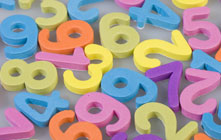Teaching Math to Students with Learning Disabilities
Teaching math to students who have learning disabilities can be a rewarding challenge. Many of your students will have struggled with math for several years and will be delighted if math suddenly clicks for them. Here are a few strategies to help you successfully teach this population.

Teaching Learning-Disabled Students
Types of Learning Disabilities
- Dyslexia - difficulty reading and interpreting letters
- Dysgraphia - problems with writing
- Dyscalculia - learning disorders related only to math
A student may have only one of these disorders, or they may have more. Many strategies for teaching math are useful for children with any of these learning disabilities, as well as for children who may struggle with math because they are developing more slowly.
Teaching Number Sense
'Number sense' can be defined as understanding numbers and how they relate to one another. It's perhaps the most basic concept you can teach math students. Students with learning disorders generally have less number sense than other students. Three ways to improve number sense are:
- Concrete Objects
- Have students count every concrete object you can imagine, in the classroom and elsewhere - fingers, chairs in the room, toothpicks, trees, insects - everything!
- Repetition
- Teach each math skill over and over until the child masters it. Model the process for them. Repeat counting or addition tables with students if they have made an error when saying the tables alone. Create opportunities for students to figure out problems, such as, 'I want to give everyone in row one three counting sticks. How many do we need to take from the box?'
- Connections
- Help students become thoroughly familiar with the 'language' of math. Tie every math symbol and term to examples of how they are used. Use books, calendars, graphs from magazines or newspapers, maps, house plans - anything! Have math conversations with the students at every opportunity, using words that they are learning. Be sure they understand the meaning of math terms. For instance, 'and' tells you to add and 'groups of' tells you to multiply.
Teaching Strategies
Students with learning disabilities need to be taught problem-solving strategies. These students may find it difficult to know how to begin working on a math problem, how to make decisions and how to complete a plan of action. Explicitly teach methods to approach all of these problems to give the student a plan that details what steps to take and in what order.
One strategy for word problems is the first-letter mnemonic STAR:
- Search the problem
- Translate the problem into a picture
- Answer the problem
- Review the solution
Students can make up their own mnemonics. Sentences may be easier for them to create than words. One example is 'Uncles Desire Corny Laughs' for the following problem-solving steps:
- Understand the problem
- Develop a plan to find the answer
- Carry out that plan
- Look back to see if the answer truly solves the problem
Teaching Strategically
The sequence of strategies used in teaching learning-disabled students makes a huge difference in helping these students catch on to a new math fact. Begin with concrete, 3-dimensional manipulative objects, such as tiles or blocks. Once children can easily demonstrate a math fact with a variety of manipulatives, move to 2-dimensional drawings (using squares, triangles, etc.) and pictures. When the children can come up with their own drawings, you can move on to using numbers and math symbols.
The more ways you can present and illustrate math facts, the more likely you are to offer something helpful for every student. Use manipulatives, stories, poems, pictures, music (both to sing and to listen to), physical activities and games. Practicing and drilling are still important. Even learning-disabled students will benefit from using flash cards and speed drills; help them to compete with themselves rather than other students.
Other Articles You May Be Interested In
-
Are Math Struggles Due to Poor Instruction or Real Learning Disabilities?

In a way, it's sort of the 'chicken or the egg' question: do learning disabilities lead to a greater struggle in math class or does poor instruction lead to deficits that result in a learning disability? Of course good instruction plays an integral part in learning math. Could better teaching help your child if he or she is...
-
MIND Games Lead to Math Gains

Imagine a math teaching tool so effective that it need only be employed twice per week for less than an hour to result in huge proficiency gains. Impossible, you say? Not so...and MIND Research Institute has the virtual penguin to prove it.
We Found 7 Tutors You Might Be Interested In
Huntington Learning

- What Huntington Learning offers:
- Online and in-center tutoring
- One on one tutoring
- Every Huntington tutor is certified and trained extensively on the most effective teaching methods
K12

- What K12 offers:
- Online tutoring
- Has a strong and effective partnership with public and private schools
- AdvancED-accredited corporation meeting the highest standards of educational management
Kaplan Kids

- What Kaplan Kids offers:
- Online tutoring
- Customized learning plans
- Real-Time Progress Reports track your child's progress
Kumon

- What Kumon offers:
- In-center tutoring
- Individualized programs for your child
- Helps your child develop the skills and study habits needed to improve their academic performance
Sylvan Learning

- What Sylvan Learning offers:
- Online and in-center tutoring
- Sylvan tutors are certified teachers who provide personalized instruction
- Regular assessment and progress reports
Tutor Doctor

- What Tutor Doctor offers:
- In-Home tutoring
- One on one attention by the tutor
- Develops personlized programs by working with your child's existing homework
TutorVista

- What TutorVista offers:
- Online tutoring
- Student works one-on-one with a professional tutor
- Using the virtual whiteboard workspace to share problems, solutions and explanations